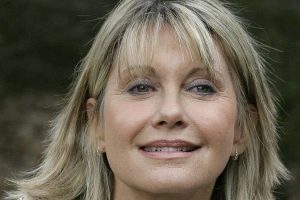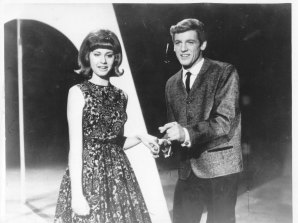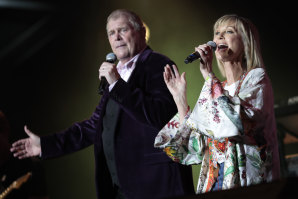Grease was the catalyst for superstardom, cancer research became her life’s cause

OLIVIA NEWTON-JOHN 1948-2022
Grease was not just the word, it was the movie and soundtrack that oiled Olivia Newton-John’s surge from star to superstar. A chance meeting with producer Allan Carr at a dinner party hosted by Newton-John’s friend Helen Reddy led to her being offered the lead role of Sandy alongside John Travolta. The film became the biggest-selling movie musical at the time, and the soundtrack album shot to No.1, stayed there for nine weeks and went on to sell 25 million copies. Singles plucked from the record gave Newton-John five major hits, including You’re The One That I Want – one of the all-time biggest singles.
Her film transformation from a sweet Doris Day-type to a lusting sex kitten also marked a turning point in how Newton-John viewed her own potential as a performer and proved liberating for her career.
She was initially wary of accepting the role after the disaster of her one previous film foray, Toomorrow (1970), which rightly vanished upon release. She was also worried about being too old for the role. Even after a successful screen-test (at her insistence), she needed to be persuaded by Travolta, who considered her the “one person on this planet who could be Sandy”. Afterwards, she described her involvement in Grease as “the single biggest event of my life”.
That life, which has ended at the age of 73 after a battle with breast cancer that was first diagnosed 25 years ago returned in her spine, began in Cambridge, England, on September 26, 1948, as the third child of Brinley and Irene Newton-John.
The latter’s father was the German physicist and mathematician Max Born, who won the 1954 Nobel Prize in physics. It was Brinley’s mother, Daisy, who originated the Newton-John name by adding her surname to her husband’s, Oliver John. Brinley (or Brin) excelled at music and theatre and had intended to become an opera singer, but it was his prowess with languages that won out, and he went on to help crack the Germans’ Enigma Code during World War II.
In 1954, the family moved to Australia, where Brin became a professor at the University of Melbourne, divorcing Irene when Olivia, then 10, was attending Christ Church Grammar School. At University High School, she formed a folk group called the Sol Four, and tossed up between becoming a singer, vet or mounted policewoman. She developed a romantic attachment with the future television star Ian Turpie and won a TV talent quest carrying the prize of a trip to England. In January 1966, she and her mother boarded a ship for the country of her birth.
Once there, her debut single for Decca died without a trace. She then formed a duo with the ex-pat Australian singer Pat Carroll, and they inched their way up to support slots (including for The Seekers) and TV appearances. Newton-John met and fell in love with Bruce Welsh, second guitarist with the Shadows, who left his wife to embark on a live-in relationship. Through this association, she sang background vocals on some Cliff Richard songs (the Shadows being his backing band), and in 1969 was chosen to be part of a manufactured Anglo-American group Toomorrow, an embarrassing failure for all concerned.
The antidote to that disaster was her eponymously titled first album, which gave her mild hits with a cover of Bob Dylan’s If Not For You followed by Banks of the Ohio. She became a weekly guest on the BBC-TV’s It’s Cliff Richard, giving her massive UK exposure, and had a third hit with a cover of George Harrison’s What is Life?
In March 1972, she broke up with Welsh, and the following year had her first significant US hit with Let Me Be There, while also beginning a relationship with businessman Lee Kramer, who took over her management with no prior experience. In 1974, she sang the unfortunate Long Live Love as Britain’s Eurovision entry – soundly beaten by Abba’s Waterloo.
Reddy talked Newton-John into moving across the Atlantic, and she had her first US No.1 single with I Honestly Love You (co-penned by Peter Allen and Jeff Barry) and No.1 album with If You Love Me Let Me Know, whereupon the Country Music Association voted her female vocalist of the year ahead of the likes of Dolly Parton and Loretta Lynn, dislocating a few Nashville noses.
By the end of 1975, she was the biggest-selling female singer in America, one who could lease a private jet for travel and buy a mansion near Malibu, where, ever an ardent animal-lover, she kept horses, dogs and a cat. The following year, she hosted her own TV special, and then came Grease, superstardom and a licence to record what she liked, as she did on Totally Hot, her first album after the movie.
Inevitably, the massive success of Grease had Newton-John and the industry on the lookout for a follow-up film project, resulting in 1980’s Xanadu, a mangled fantasy that would prove mortifying for both her and co-star Gene Kelly. It did, however, give her five more hits, including the title song, and it introduced her to the man who became her first husband, the dancer/actor Matt Lattanzi, an unknown 11 years her junior. They married in 1984, their daughter, Chloe, was born in January 1986, and they divorced in 1995.
The degree to which Grease had liberated Newton-John in her song choice was never more obvious than when, in 1981, she released the racy Physical, which was banned in some places – no doubt helping it to 10 weeks at the top of the charts, while the eponymous album also enjoyed considerable success, as did a related TV special.
Olivia Newton-John on the Australian teenage show Sing, Sing, Sing in 1965.Credit:Fairfax Archives
In 1982, she and Travolta reunited for the movie Two of a Kind, which did neither any favours. Although she partially bounced back with the raunchy Soul Kiss album, the rest of the 1980s would be much more about marriage, motherhood and her chain-store venture Koala Blue (retailing Australian products) than her singing career.
When Koala Blue collapsed in 1991, Newton-John planned a return to singing, but the following year brought twin bouts of bad news: the death of her father and a breast cancer diagnosis. She underwent successful surgery followed by eight months of chemotherapy, and when she returned to work, it was to take her first dramatic role in the independent movie It’s My Party.
In 1993, she, Lattanzi and Chloe moved from Malibu to a farm near Byron Bay, and despite the therapy of a back-to-earth lifestyle being the primary focus, she found herself writing unlooked-for songs that resulted in the 1994 album Gaia: One Woman’s Journey. Her career remained intermittent during the 1990s. In 2000, she enjoyed playing Bitsy-Mae in the film Sordid Lives, billed as “a black comedy about white trash”.
In 2003, her mother died, and in 2005, her romance with cameraman Patrick McDermott ended in mystery when he unaccountably failed to return from a Californian fishing trip. In 2008, she married American businessman John Easterling, who is known as “Amazon John” for his use of South American herbs in his alternative health business.
Olivia Newton-John and John Farnham perform during Fire Fight Australia at ANZ Stadium in February 2020 in Sydney, Credit:Getty Images
His promotion of natural remedies was adopted by Newton-John after her cancer returned in 2017. She supplemented her surgical, chemotherapy and radiotherapy treatment with use of medical cannabis grown by Easterling on their ranch near Santa Barbara, California. “I was nervous of it in the beginning,” Newton-John told the Guardian in 2020. ″But I could see the benefits once I started using it. It helps with anxiety, it helps with sleep, it helps with pain.”
Newton-John described her cancer as “a gift” that she saw as her “life’s journey”. “It gave me purpose and intention and taught me a lot about compassion,” she said. That purpose included her passionate support of cancer sufferers and cancer research, and her dedication to that cause led to the establishment in 2014 of the Olivia Newton-John Cancer Research Centre at Melbourne’s Austin Hospital. She said she was proud that the global research performed at the centre continued her family’s contribution to science.
In February 2020, Newton-John gave her star power to a concert in Sydney to raise relief funds for Australia’s bushfire victims, joining John Farnham on stage for a duet.
Throughout her career, Newton-John was frustrated at her success being attributed to her looks rather than her voice, and also at being put down for not adhering to pop stereotypes of drug use and promiscuity. Perhaps the relative blandness of the brand of pop she espoused did not help her cause, but when her star was in the ascendancy, it rose very high indeed. She is survived by Easterling and her daughter, Chloe.
A cultural guide to going out and loving your city. Sign up to our Culture Fix newsletter here.
Most Viewed in National
From our partners
Source: Read Full Article


